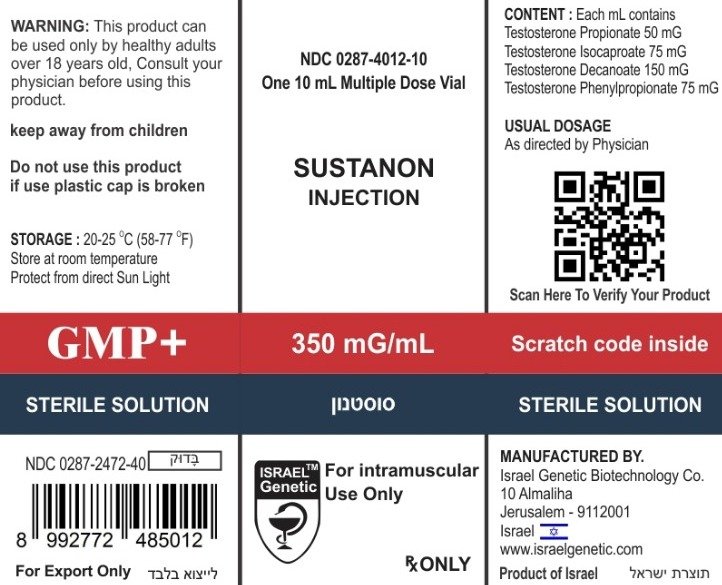
Sustanon is a clear pale yellow solution for intramuscular injections containing four testosterone esters. Testosterone is a natural male hormone known as an androgen. In men, testosterone is produced by the testicles. It is necessary for the normal growth, development and function of the male sex organs and for secondary male sex characteristic. It is necessary for the growth of body hair, the development of bones and muscles, and it stimulates the production of red blood cells. It makes also men’s voices deeper. Sustanon is used in adult men for testosterone replacement to treat various health problems caused by lack of testosterone (male hypogonadism). Sustanon is used as supportive therapy for female-to-male transsexuals.
Sustanon contains a number of esters of testosterone with different durations of action. The esters are hydrolyzed into testosterone, as soon as they enter the general circulation. A single dose of sustanon in males leads to an increase of total plasma testosterone, with peak level reached approximately in 24-48hrs after administration. Plasma testosterone levels return to the lower limit of the normal range in males after approximately 21 days.
In female-to-male transsexuals, a single dose of sustanon repeated every two weeks resulted in mean trough testosterone levels towards the upper end of the normal male range in 2, 4 and 12 months. Testosterone is metabolized via the normal pathways. Excretion mainly takes place via the urine as conjugates of etiocholanolone and androsterone.
Testosterone replacement therapy in male hypogonadal disorders, for example: alter castration; eunuchoidism; hypopituitarism; endocrine impotence; male climacteric symptoms like decreased libido; certain types of infertility due to disorders of spermatogenesis. Testosterone therapy may also be indicated for the prevention and treatment of osteoporosis in hypogonadal males. Testosterone administration may also be used as supportive therapy for female-to-male transsexuals.
In general, dosage should be adjusted to the individual response of the patient.
Adults : Usually, one injection of 1ml per three weeks is adequate.
Elderly: It should be noted that smaller and less frequent doses may achieve the same response.
Children: It should be noted that smaller and less frequent doses may achieve the same response. FemaIe-to-male transsexuals: Different specialist centers have used doses varying from one injection of 1ml every two weeks to one injection of 1ml every four weeks.
Administration: deep intramuscular injection
Patients, especially the elderly, with the following conditions should be monitored:
-ischaemic heart disease, since androgens may produce hypercholesterolaemia.
-latent or overt cardiac failure, renal dysfunction, hypertension, epilepsy or migraine (or a history of these conditions), since androgens may occasionally induce fluid and sodium retention.
– skeletal metastases, since androgens may induce hypercalcaemia or hypercalciuria in these patients.
Long term monitoring should include measurement of hemoglobin. The use of steroids may influence the results of certain laboratory tests. Androgens should be used cautiously in prepubertal boys to avoid premature epiphyseal closure or precocious sexual development. If androgen-associated, adverse reactions occur, sustanon treatment should be interrupted and, after disappearance of the symptoms, be resumed with lower doses.
Before initiating sustanon for female-to-male transsexuals, specialist assessment should be undertaken, including psychiatric assessment. A complete personal and medical history should be taken. During treatment, periodic check-ups are recommended of a frequency and nature adapted to the individual. The following should be monitored:
– signs of osteoporosis,
– changes in lipid profile.
In patients with a personal or family history of breast cancer and with a personal history of endometrial cancer, careful monitoring should be made. According to specialist, hysterectomy and bilateral oophorectomy should be considered after 18-24 months of testosterone treatment, to reduce the possible increased risk of endometrial and ovarian cancer. Continued surveillance is required to detect osteoporosis in patients who have undergone oophorectomy, as testosterone may not fully reverse the decline in bone density in these patients. Continued surveillance is required to detect endometrial and ovarian cancer in patients on long term treatment who have not proceeded to hysterectomy and bilateral oophorectomy.
Known or suspected prostatic or mammary carcinoma; Pregnancy; Breast-feeding; Hypersensitivity to the active substance or to any of the excipients; Drug interaction; Enzyme-inducing agents may exert increasing or decreasing effects on testosterone levels. Therefore adjustment of the dose, and/ or intervals between injections may be required.
Based on its pharmacological effect, sustanon is suspected to cause birth defects and/or other irreversible adverse effects on pregnancy outcome. Therefore, sustanon is contraindicated during pregnancy and lactation.
The following adverse reactions have been associated with androgen therapy in general:
– In prepubertal boys, precocious sexual development, an increased frequency of erections, phallic enlargement and premature epiphyseal closure,
– Priapism and other signs of excessive sexual stimulation.
– Water and sodium retention,
– Oligospermia and a decreased ejaculatory volume.
Treatment should be interrupted until these symptoms have disappeared, after which it should be continued at a lower doses. Hoarseness of the voice may be the first symptom of vocal change which may lead to irreversible lowering of the voice. If signs of virilisation develop, particular lowering of the voice, treatment should be discontinued unless the effects are desired treatment outcomes.
The following undesirable effects have also been observed: acne, disturbance of liver function, polycythaemia, hypertension, weight gain (in female-to-male transsexuals).
The acute intramuscular toxicity of sustanon is very low. Priapism in men is a symptom of chronic overdose. If this occurs, sustanon treatment should be stopped and continued with lower dose after disappearance of the symptom.
Store in a dark, dry place. Keep away from children.
1x10ml glass vial
Copyright © ISRAEL GENETIC 2020 | All Rights Reserved